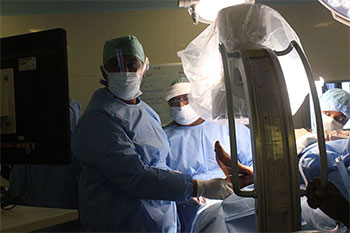Key hole surgery
Understanding Keyhole Surgery
Arthroscopic surgery, often known as keyhole surgery, is a highly specialised surgical method used by orthopaedic surgeons to cure medical issues inside a joint. Because it is conducted with small incisions and sophisticated surgical equipment, it is termed keyhole surgery. The fewer the incisions, the less scarring and the quicker the healing.
What is Arthroscopy?
The name arthroskopein is derived from two Greek words: arthro, which means joint, and skopein, which means to examine within. As a result, it is a process that examines the interior of a joint in order to cure diseases or injuries. This type of minimally invasive orthopaedic surgery necessitates the utilisation of cutting-edge technology and methods.
An arthroscope is a pencil-sized tool that is introduced into the body through a tiny incision. The arthroscope contains a small camera and lighting system that transmits real-time pictures to a video monitor in the operating room. The surgeon can examine the joint in great detail, determine the type and degree of the ailment or injury, and proceed with surgical treatment. Initially, arthroscopy was only a diagnostic procedure performed with a small camera, but with the development of specialised surgical equipment and procedures, it has evolved into a full surgical surgery.
How is Arthroscopy Performed?
While arthroscopy, like other forms of laparoscopic surgery, is beneficial for the patient in terms of recovery time, it does necessitate the use of specialist equipment and surgical instruments and is conducted in an operating room.
The sort of anaesthetic used will be determined by the joint that has to be healed. After that, the arthroscope is introduced through a tiny incision (or numerous incisions if the bone is to be seen from different angles) the size of a keyhole. When the orthopaedic surgeon determines the scope of the problem, specialist tiny instruments will be employed to correct it.

What are the Benefits of Arthroscopy?
Arthroscopy gives the surgeons a clear and up-close view of the joints that has to be repaired. He has the ability to observe even the tiniest details and precisely regulate the motion of the tools used in the operation. This not only makes the surgeon’s job easier, but it also allows for very accurate and rapid operative actions.
The following are some of the advantages to the patient:-
- Because the operation is frequently faster than standard methods, the time spent under anaesthesia is reduced.
- In many circumstances, it may be performed as an outpatient operation, helping patients to return home within a few hours. Even if it is performed as an inpatient operation, the amount of time hospitalisation is usually reduced.
- There is far less bruising after surgery.
- The time it would take to recuperate and restore joint mobility is shorter.
On which Joints can Arthroscopy be used?
Arthroscopy is used to assist in the diagnosis of joint disorders or injuries, such as those that involve the:
- Shoulder
- Elbow
- Wrist
- Hip
- Knee
- Ankle
What are the Risk Factors?
Arthroscopic surgery, like other types of keyhole surgery, has less risks than regular operations. The following are some of the hazards, but they are uncommon:
- Infections
- Excessive swelling
- Excessive bleeding
- Deep vein thrombosis (blood clots that form in a vein)
- Damage to nerves or blood vessels
- Instrument breakages during the procedure
It is important to note that problems occur in fewer than 1% of all arthroscopic procedures, and if they do, they may be treated well.
What is the Recovery Time?
The recovery will be influenced by the joint that is operated on, the patient’s overall health, and other medical considerations, as with any surgical treatments. The little incision will heal in a few days on average. The surgical dressing may usually be removed the next day, and sticky strips are used to seal the healing wound.
Although the scar and joint discomfort are far less than with standard surgical treatments, total healing may take several weeks. Rehabilitation or physiotherapy may be required as part of the healing process, based on the joint in issue. Limited mobility, such as returning to work or school or beginning a few other everyday tasks, may be achievable a few days following surgery, dependent on the joint.
